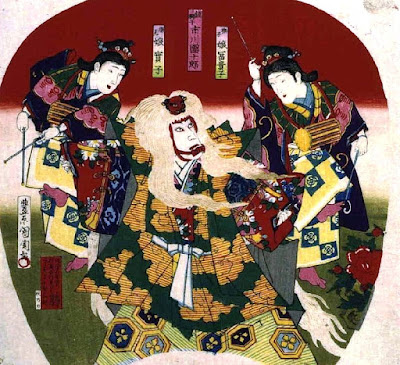目次 / Contents
1) 歌舞伎公演 / Discover Kabuki
2) 物語 / Story
1) 歌舞伎公演 / Discover Kabuki
2) 物語 / Story
 |
定式幕 ; 萌葱 (モエギ)・柿・黒の三色
"歌舞伎揚" のパッケージカラーは、やっぱりここから(笑)?
国立劇場はこの色の組み合わせですが、
Kabuki Curtain ; the three colours ;
Moegi (Spring Green)・Persimmon・Black
|
Rは、歌舞伎を観たことがありませんでした。
彼にぴったりの歌舞伎公演を見つけました。
Discover KABUKI-外国人のための歌舞伎鑑賞教室-(★)
国立劇場
14:30 ~
『新皿屋舗月雨暈 (シンサラヤシキツキノアマガサ/1883)』
「―魚屋宗五郎(サカナヤソウゴロウ)― 二幕三場」
河竹黙阿弥 (カワタケモクアミ/1816 -1893) 作
漫画で物語のあらすじが紹介されています→★
歌舞伎の基礎説明→★(日本語と英語/ in Japanese and English)
この教室(公演)は、毎年6,7月に催されるようです。
最初に歌舞伎の基礎知識と物語のあらすじが実演やスライドを含めた説明が、日本語と英語の両方でありました。
私は歌舞伎体験はありますが、歌舞伎初心者であることに変わりがないので、この説明をなるほど〜と思いつつ、楽しく聞き、観ました。
次に、実際の歌舞伎を作品の見せ場:二幕三場のみを鑑賞しました。
 |
日本語のちらし
Leaflet in Japanese All Kabuki actors are male. |
Discover Kabuki
R hadn't seen Kabuki.
I found out about a performance of Kabuki which suited R very well.
Discover KABUKI →★ in English
National Theatre (Large Theatre)
14:30 ~
I heard that nowadays they perform 'Discover KABUKI' in June and July every year.
First of all, they showed and explained the foundations of KABUKI and a summary of the story with demonstrations and slides in Japanese and English.
I have seen Kabuki a few times although I am still a beginner for Kabuki, so I was impressed and enjoyed 'Part Ⅰ'.
In Part II we appreciated the Kabuki playing of just the highlight scenes.
Main Cast : Sakanaya Sogoro : The third NAKAMURA Hashinosuke : the eighth Nakamura Shikan.
 |
| この日の私たちの席は1階 聞くところによると、歌舞伎座は舞台があまり見えない席が少なからず ありますが国立劇場は全部の席から舞台が見えるようです。 チケットも公平に全て売られるようです。 Today, Our Seats are on the Ground Floor I heard that Kabuki-za (in Ginza, the principal theatre in Tokyo for the traditional kabuki drama form) has a few seats from which audiences cannot see all the stage, however, in the National Theatre people can see all the stage from all seats . And also all the tickets are available. |
2) 物語 / Story
『新皿屋舗月雨暈』は、"皿屋敷" ('播州皿屋敷'・'番町皿屋敷') をもとにした物語です。
作者の河竹黙阿弥 (カワタケモクアミ/1816 -1893)は、江戸時代幕末から明治にかけて活躍した歌舞伎狂言作者です。
河竹黙阿弥について、Wiki より : 下記
"黙阿弥はまた、現実的な内容をあくまでも写実的に、それでいてどこまでも叙情的に描くことに秀でていた。
黙阿弥の演目の多くは市井の人、それも社会の底辺で喘ぎながら、毎日を綱渡りのようにして暮らしをしている者を主人公としている。
それでいて下座音楽に浄瑠璃が多用されているため、全体の雰囲気が陰鬱さに包まれることがなく、情緒豊かで印象的な叙事詩に仕上げられている。"
'魚屋宗五郎'の演目も、そういうものの一つなのかもしれないと思います。
結末を言ってしまいますが...最後、お殿様が町人の宗五郎に「悪かった」と頭を下げます。
そのことは、発表当時の感覚からいうと、びっくり仰天、な〜〜〜んかとってもすっきりの事柄ですが、現在の観客にとってはそれほどの感情の動きを得ることはできません。
現在は、歌舞伎の存在がちょっとね、お高い感じになっていますが、もとは大衆芸能のひとつだったのですよね。
数の子のような...という例えは私にしか通じないかも?(笑)
発表当時は全幕通して公演されたようですが、だんだんと、
後半部分 : '魚屋宗五郎'
のみが演じられるようになりました。
前半 [通称 "お蔦殺し(オツタゴロシ)"] には、結構エゲツない場面 (拷問場面とか) があり、本家の"皿屋敷" を思わせもしますが、この日に演じられる
後半 [魚屋宗五郎] は、笑いと泣きの部分です。
魚屋宗五郎を演じるのは、中村 橋之助 (三代目 中村 橋之助)、2017年6月の現在は
八代目 中村 芝翫(ナカムラ シカン/ 1865 -) : ★(←ここで姿が見られます)。
私たちが観たのは、芝翫の襲名 (2016年10月) 前の舞台だったのですね。
ちなみに奥さんは三田寛子 (1966 -)さんです。
Rは歌舞伎をとても楽しみ、この教室に参加したことをとても喜びました。
また歌舞伎を観たいと言っていました。
彼の初歌舞伎体験は成功したようです。良かった!
 |
| 歌舞伎狂言作者、河竹黙阿弥 (カワタケモクアミ/1816 -1893) A dramatist of Kabuki or Kyōgen Kawatake Mokuami (1816 -1893) 画像は下記より / This from below Wiki |
Story
"Shin-Sarayashiki Tsuki no Amagasa" was based on "Banchō Sarayashiki " .
About "Sarayashiki" from Wiki below
"Banchō Sarayashiki or Bancho Sarayashi is a Japanese ghost story of broken trust and broken promises, leading to a dismal fate.
The story of Okiku and the Nine Plates is one of the most famous in Japanese folklore, and continues to resonate with audiences today."
The dramatist of Kabuki or Kyōgen , Kawatake Mokuami (1816 -1893).
About him from Wikipedia below
[It has been said that "as a writer of plays of Kabuki origin, he was one of the greatest, if not the greatest, Japan has ever known."
He wrote 150 or so plays over the course of his fifty-year career, covering a wide variety of themes, styles, and forms, including short dance pieces, period plays, contemporary genre pieces, tragedies and comedies, as well as adaptations of foreign (Western) stories, ~ ]
When the work : "Shin-Sarayashiki Tsuki no Amagasa" was released, they played the whole story, although gradually they had tended only to play the later part : "Sakanaya Sogoro".
The earlier part : the common name; Otuta-goroshi ; Killing Otsuta, has nasty scenes (like torture) which reminds me of the original, "Banchō Sarayashiki", however, the later part was played on the day which has joy and sorrow.
At that time the third Namakura Hashinouke played as Sakanaya Sogoro.
Now (June 2017) he is the eighth Nakamura Shikan : ★ (←you can see him here).
We saw his performance before he succeeded to the name : the eighth Nakamura Shikan in October 2016, didn't we?
R really enjoyed Kabuki and was pleased with the event.
He said he would see and visit again.
His first experience of Kabuki looked successful. Good!

鏡獅子 (カガミジシ), 1958
国立劇場に展示されている大きな人形 : ★。
をモデルにして、20年以上かけて作った、高さ2メートルの木彫作品。
鏡獅子(『春興鏡獅子』・通称 "鏡獅子") は、六代目の当たり役でした。
"鏡獅子"は、一人の俳優が'娘'と'獅子の精'を演じます。
Kagamijishi, 1958
The figure is displayed in the National Theatre : ★.
Hirakushi Denchū (1872 -1979) was working on this wood carving ; height : 2m
for over 20 years, and was based on the sixth Onoe Kikugoro (1885 - 1949) : ★. "Shunkyo - Kagamijishi" ; common name, Kagamijishi
The role of Kagamijishi was arguably played most successfully
by the sixth Onoe Kikugoro. The story is about a lovely girl, but who does become a Lion spirit. One male actor plays the two roles. Film in English →★ (But a different actor) |
 |
| 『春興鏡獅子』 九代目市川團十郎 (1838 -1903) の鏡獅子。 1893(明治26)年、豊原国周 (トヨハラクニチカ / 1835 -1900) 画。 団扇絵として描かれたもの。 "Shunkyo - Kagamijishi" 'Kagamijishi' by the ninth Ichikawa Danjūrō (1838 -1903). Picture as Uchiwa-e, 1893 by Toyohara Kunichika (1835 -1900) 画像は下記より / This from below Wiki |






0 件のコメント:
コメントを投稿